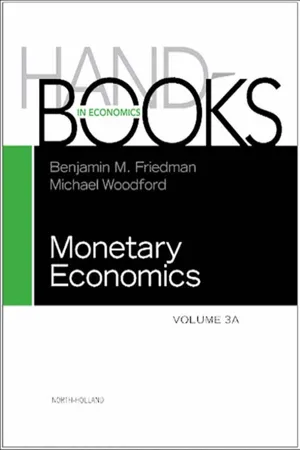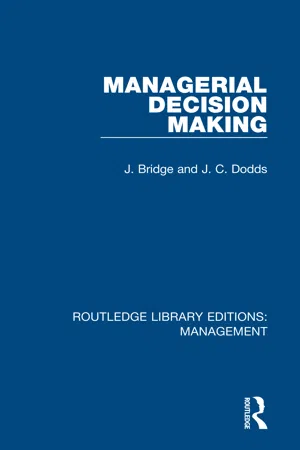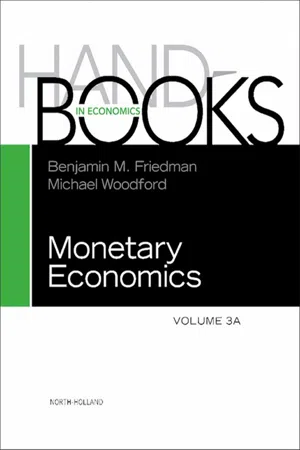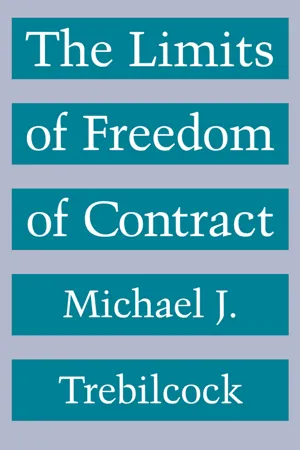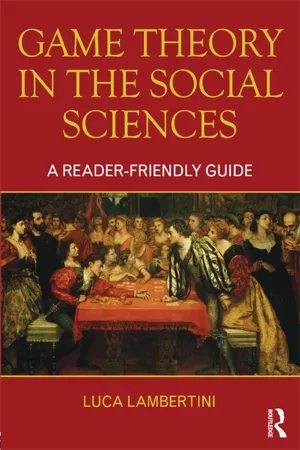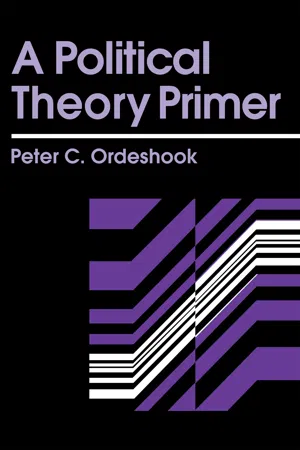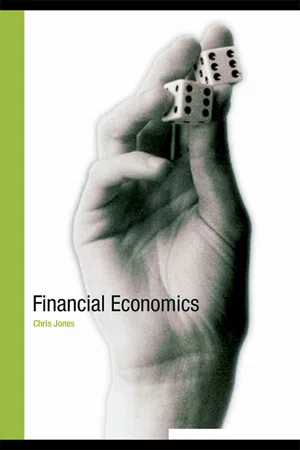Economics
Imperfect Information
Imperfect information refers to a situation where individuals or firms do not have complete knowledge about the market, leading to uncertainty and potential inefficiencies. In economics, this concept highlights the challenges of decision-making when relevant information is unavailable or costly to obtain. Imperfect information can result in market failures and suboptimal outcomes.
Written by Perlego with AI-assistance
Related key terms
Related key terms
1 of 4
Related key terms
1 of 3
7 Key excerpts on "Imperfect Information"
- eBook - ePub
- Benjamin M. Friedman, Michael Woodford(Authors)
- 2010(Publication Date)
- North Holland(Publisher)
(12). Here it follows because a linearization of the optimality conditions is equivalent to a quadratic approximation of the objective function. 7 This property has been used at least since Simon (1956) to make problems of incomplete information easier, and we will often (but not always) rely on it. The Imperfect Information equilibrium is defined as the values of y t and p t such that Eqs. (13), (14) and (18) hold. To complete the model, the only ingredient that needs to be added is a specification of how firms form expectations. 8 3 Foundations Of Imperfect-Information and Aggregate-Supply Models If the firm has neither limits to its rationality nor any constraints on its ability to process information, then more information is better. The firm can always freely dispose of the information, and in general the ability to make more accurate forecasts will allow it to make decisions that yield higher expected profits. 9 To justify why people do not have full information therefore requires the presence of some information or rationality cost, k. 10 The cost can be real resources or utility losses, may be variable or fixed, and may even be implicit in the form of shadow multipliers on an information constraint. Section 6, on the microfoundations of Imperfect Information, is devoted to models of these costs. In this section, we discuss the choices that these information costs generate. 3.1 What to choose and plan? With full information, we can think of the firm as either choosing the quantity of output to produce or the price to set. Choosing one of them instantly determines the other via the demand function. For instance, if the firm chooses its price, then using its information on aggregate output and the price level, it knows exactly the amount of output it will produce. With Imperfect Information, these two options are no longer equivalent - eBook - ePub
- J. Bridge, J. C. Dodds(Authors)
- 2018(Publication Date)
- Routledge(Publisher)
2 Imperfections In Knowledge2-1 Informational Requirements in Decision Making
Economists advocate marginal analysis and opportunity costing in the evaluation of decision alternatives. This necessitates information about costs, revenue and alternative uses for productive facilities, but in the real world this information is imperfect. In fact informational deficiencies become apparent even before the evaluation stage is reached in the decision process, because the possible courses of action themselves may not be fully known. In practice decision alternatives are generated by a search process and the latter being constrained by time (and cost!) will seldom if ever reveal all possible ways of achieving objectives or solving a particular problem. Consequently the alternatives which are considered are only a subset. Then, when the decision maker does reach the evaluation stage of the process, he will not have the precise information he ideally requires. Economics being a social science can never state exactly what the costs and effectiveness of a particular pattern of resource allocation will be. While, for example, an economist would be able to indicate whether or not a decision to increase price would improve sales revenue from a particular product, details of the precise change will in general not be available.In order to improve the analysis of decision making, given imperfect knowledge, decision theory has evolved. Decision theorists have tended to concentrate on the lack of certainty surrounding outcomes rather than the problem of discovering all alternative solutions to a particular problem. What decision theory attempts to achieve is an improvement in the selection procedure – the choice among alternatives, given that each course of action can result in a number of possible outcomes.2-2 Strategies, Pay-Offs and States of Nature
Decision theory has a terminology of its own. The decision alternatives are called ‘strategies’ and are denoted by the symbol S. The outcome of each strategy, often given monetary values, are referred to as ‘pay-offs’, to which are given the symbol P. There is no reason why this classification cannot be used for the analysis of decisions under certainty. For example a problem may consist of choosing from four options, each having a known pay-off. The problem could be drawn up as in Table 2.1 , where the options are presented by S1 , S2 . S3 , and S4 and the pay-offs associated with each by P1 , P2 , P3 , and P4 respectively. In game theory, which we cover in Chapter 6 - eBook - ePub
- (Author)
- 2010(Publication Date)
- North Holland(Publisher)
Lucas (1972) formalized these ideas in a model in which some agents observe the prices of the goods they produce but not, contemporaneously, the prices of the goods they purchase. Because of this Imperfect Information, when households observe prices, they face a signal extraction problem to sort out movements in relative prices from movements in the overall price level. The result of this temporary confusion is a short-run Phillips curve.Following Lucas, a large literature on Imperfect Information models developed. Some of it was empirical. Barro (1977) , for instance, presented results suggesting that the distinction between anticipated and unanticipated movements in money was in fact crucial for explaining the real effects of money. Some of it was theoretical. Townsend (1983) , for instance, emphasized how, under Imperfect Information, people can have different information and thus different expectations, and so forecasting the forecasts of others could be a central element of economic dynamics. In the 1990s, however, this literature went into hibernation. Other theories, including real business cycle models and new Keynesian sticky-price models, took center stage in discussions of economic fluctuations.This chapter reviews the literature from the 2000s that revives Imperfect Information as a key to understanding aggregate supply and the Phillips curve. This work differs from the older work in three important, related ways. First, in the new models, information disseminates slowly rather than being perfectly revealed after some brief delay. The older literature assumed that the only obstruction to full information was the unavailability of data, whereas the new work starts from the realization that even when data on aggregates are available, it takes time and resources for people to process this information so they will only gradually incorporate it into their actions. Second, the new work places a greater emphasis on the heterogeneity of expectations that comes with dispersion of information. It is the interaction between agents that are differentially informed that generates new theoretical questions. Third, whereas the older literature had limited strategic interactions, in the new work they take center stage. 1 - eBook - ePub
- Michael J. Trebilcock(Author)
- 1997(Publication Date)
- Harvard University Press(Publisher)
CHAPTER FIVEAsymmetric Information Imperfections
The Nature of the Conceptual Problem
Even the most committed proponents of free markets and freedom of contract recognize that certain information preconditions must be met for a given exchange to possess Pareto superior qualities. For example, to recall the statement of Milton Friedman: “The possibility of coordination through voluntary cooperation rests on the elementary—yet frequently denied—proposition that both parties to an economic transaction benefit from it, provided the transaction is bilaterally voluntary and informed. ”1In this chapter, the organizing assumption is that one party to a contract is substantially less well informed about some aspect of the contract subject matter than the other party, and in the light of this assumption, I ask whether in some cases contracts should not be enforced on that account, or enforced on different terms, and why. The relevance of this question to both autonomy and Paretian welfare justifications for private exchanges will be obvious. In autonomy terms, Kim Lane Scheppele argues:Information plays a dual role in rational choice theory. On the one hand, it is a precondition of choice. That is, one needs a certain amount of information in order to be able to imagine one’s alternatives, to understand enough of their implications to be able to distinguish among them, and to assess which one would best realize one’s aims. All of this requires quite a lot of knowledge and, generally speaking, the more the better. On the other hand, knowledge is itself an object of choice; that is, one can choose whether to acquire more information. Whether one decides to acquire more information depends not only on what one already knows but on one’s estimates of the chances that more knowledge will improve the decision enough to be worth one’s efforts. Generally speaking, in such a situation the less additional knowledge one needs, the better.2 - eBook - ePub
Game Theory in the Social Sciences
A Reader-friendly Guide
- Luca Lambertini(Author)
- 2011(Publication Date)
- Routledge(Publisher)
market failures. That is to say, the allocation of goods and services will be, in general, inefficient, as any uneven distribution of relevant information across the population of agents is bound to affect their incentives and the resulting price or wage schedule.You may guess that a repeated game over an infinite horizon may open the way to a different equilibrium. Well, yes, this is indeed the case. The extension to allow for repeated interaction is illustrated below, in the section dedicated to incomplete information, where we will resort to a supergame in order to revisit the lemons problem. We will contrast this perspective with the simpler case where the game takes place only twice, to highlight the bearings of incomplete information and reputation on players’ strategies and ultimately on the equilibrium outcome of the game.9.2 Incomplete information
Governments never learn.Only people learn. Milton FriedmanInformation incompleteness is usually captured in games by the assumption that some of the players do not know one or more relevant features characterizing the identity of other players. This is formalized by the notion of player type, as we have briefly seen in the game about the market for lemons. Uninformed players only know the exogenously given probability distribution of the rivals’ types.To solve games taking place under incomplete information, one has to construct a refinement of the Nash equilibrium concept, which was originally constructed for games of complete information. Thanks to a very smart transformation that was introduced by John Harsanyi (1967/68), an incomplete information game can in fact be solved as one in which information is complete but imperfect. The resulting solution concept is called Bayes–Nash or simply Bayesian equilibrium, and relies upon the so-called Bayes’ rule. The rigorous derivation of the latter requires some basic concepts of statistical inference that I will confine to the appendix to this chapter. Here, it will be sufficient to explain the matter in purely intuitive terms. - eBook - ePub
- Peter C. Ordeshook(Author)
- 2020(Publication Date)
- Routledge(Publisher)
5 Games With Incomplete Information5.1 Incomplete Information
Thus far we have assumed that any uncertainty we choose to incorporate into our models has nature’s random moves as its source. More importantly, if nature’s moves are revealed to one person, we assume that they are revealed to everyone, so that there are no informational asymmetries—no one has any private information, aside, possibly, from the choices they make as the situation unfolds. More generally, though, many important political processes can be modeled only if we assume that decision makers have private information, such as the details of their own preferences or their capabilities. A great many examples and subsidiary questions come easily to mind:What costs are terrorists willing to incur after hijacking a plane, and how willing should a government be to make concessions or to risk sacrificing hostages?What are a weapon system’s capabilities that might not be observable or measurable by other countries, and how does this asymmetry in information affect the willingness of countries to engage in arms control negotiations?How can a congressional committee monitor and regulate an executive agency when it knows that the agency will have better information about the program’s performance than Congress once that program goes into effect?How should we approach a negotiation if we don’t know an adversary’s willingness to compromise or how it values time? When some voters are informed about a legislator’s actions and others are not, what weight will the legislator give to the informed versus the uninformed members of his constituency? With respect to the important issue of strategic deterrence, will a country be willing to actually implement its threat to launch a mutually costly counterattack if attacked?These examples have one common element: One person knows something that another does not know—costs, capabilities, policy position, program performance, and so on. Thus, it appears that parts of the extensive forms that we might create to represent these situations will be unknown to different persons and, therefore, that answering these questions will require tools in addition to the ones that previous chapters offer. Indeed, we will have to augment our tools, because the asymmetric information in our examples opens the door to new and more complicated forms of “he-thinks-that-I- think” regresses and to more complicated forms of strategic interaction. - eBook - ePub
- Chris Jones(Author)
- 2008(Publication Date)
- Routledge(Publisher)
This is referred to as the mutuality principle that holds in all the consumption-based asset pricing models examined earlier in Chapter 4. We look at insurance with common (symmetric) information in Section 5.1 and then extend the analysis by introducing asymmetric information in Section 5.2. Consumers will fully insure against individual risk in a frictionless competitive equilibrium when traders have common information and state-independent preferences. We use this as a benchmark to identify the effects of trading costs and asymmetric information. Consumers choose not to fully insure when trading costs raise the price of insurance above the probability of incurring losses. When they are minimum necessary costs of trade the competitive equilibrium outcome is Pareto efficient, where expected security returns rise to compensate consumers for the cost of eliminating individual risk from their consumption expenditure. A number of government policies, including price stabilization schemes and publicly funded insurance, are justified as ways to overcome the effects of asymmetric information on private insurance. Moral hazard and adverse selection are the most widely cited problems. With moral hazard consumers have the ability to reduce their individual risk by undertaking costly self-protection. Whenever marginal effort, which cannot be observed by insurers, is not reflected in the price consumers pay for insurance, they less than fully insure. Adverse selection occurs when there are consumers with different probabilities of incurring losses that insurers cannot costlessly identify and separate. Low-risk types suffer from highrisk types buying low-risk policies. This imposes externalities on low-risk consumers. At one extreme high-risk types may prove too big a problem for the existence of a private insurance market. These are the most common reasons cited for incomplete insurance markets
Index pages curate the most relevant extracts from our library of academic textbooks. They’ve been created using an in-house natural language model (NLM), each adding context and meaning to key research topics.
Explore more topic indexes
Explore more topic indexes
1 of 6
Explore more topic indexes
1 of 4
